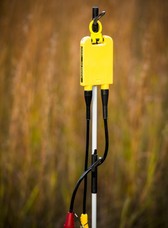The Seismic Recording Challenge
Finding a reliable antenna solution for recording accurate time and location-referenced data

The growing demand for energy worldwide is leading geoscientists to find better ways to accurately predict where oil is located and decide how it can be removed safely. Both the oil & gas and mining industries are investing heavily in smarter, more cost effective methods for streamlining seismic data operations on land and sea. Leading seismic recording companies are now turning to cable-free autonomous nodes that are capable of logging reliable high quality seismic data.
The Challenge
Before seismic recording companies are able to successfully transition away from traditional cable-based telemetry systems to autonomous nodal technology they must first solve several difficult challenges.
First, finding a reliable solution for recording accurate time and location-referenced data must be considered. The cable-based system offers real-time access to the seismic data being recorded where as with autonomous nodal technology the data is only accessible once the unit has been retrieved. Next, when deploying thousands of independent recording units in dense urban areas, rural settings, extreme climates, rough terrain and underwater, the consistent reception of GPS signals can become problematic. Each individual unit must be able to receive signals from GPS satellites, regardless of unit orientation.
Seismic recording companies have traditionally used GPS patch antenna solutions with their recording units. Patch antennas are limited to a typical radiation pattern that is linearly polarized at elevation angles close to the horizon. This often results in the malfunction of units that are not placed vertically oriented to the sky. Furthermore, patch antenna gain, axial ratio, and impedance bandwidth are heavily dependent on the size of the installed groundplane. In many situations adding a ground plane will add cost and can compromise reliability. Additionally, antennas that are manufactured using ceramic materials tend to have higher failure rates. Low production yield for ceramic antennas can result in higher total costs, longer production cycles and lower reliability.
Maxtena’s Solution
Using patented Helicore technology Maxtena’s engineering team has developed an extremely small (22mm) helix GPS antenna that is able to fit inside a device comparable in size to an iPhone. The helical design means that no ground plane is required. The antenna has an extremely wide pattern, which radiates uniformly in all directions. This allows a seismic recording unit to be oriented in any position and still receive a strong GPS signal. The high efficiency and increased bandwidth permits this single antenna to be used for multiple GPS frequencies.
Maxtena’s revolutionary antenna technology provides for industry leading reliability and our manufacturing processes produce the highest yields. This saves companies time and money and results in high quality surveys in reduced time periods at lower survey costs.
The Business Result
Using patented Helicore technology Maxtena’s engineering team has developed an extremely small (22mm) helix GPS antenna that is able to fit inside a device comparable in size to an iPhone. The helical design means that no ground plane is required. The antenna has an extremely wide pattern, which radiates uniformly in all directions. This allows a seismic recording unit to be oriented in any position and still receive a strong GPS signal. The high efficiency and increased bandwidth permits this single antenna to be used for multiple GPS frequencies.